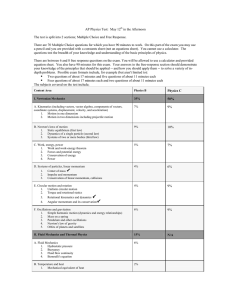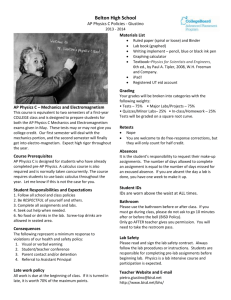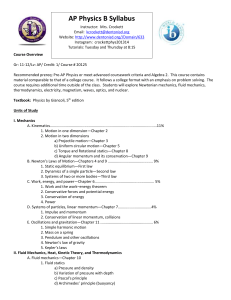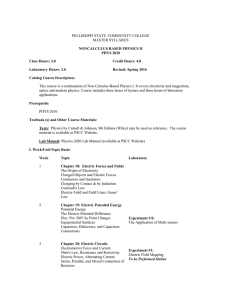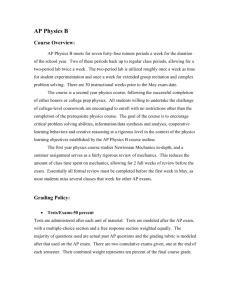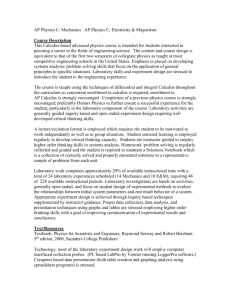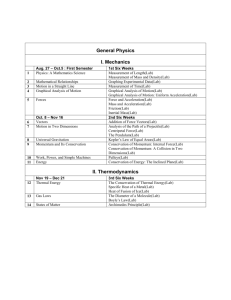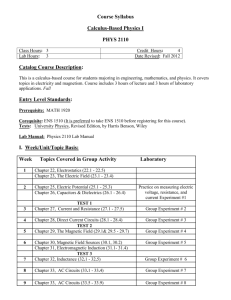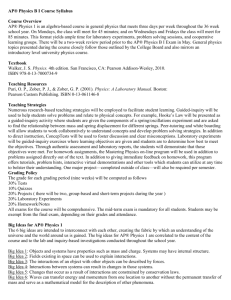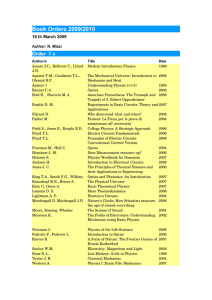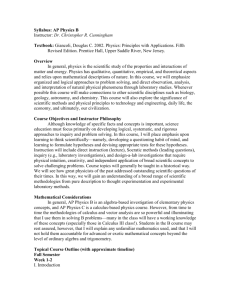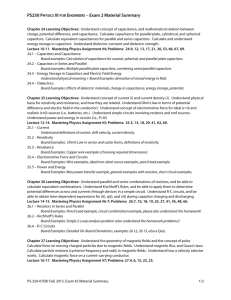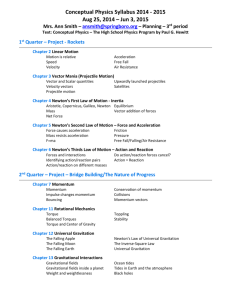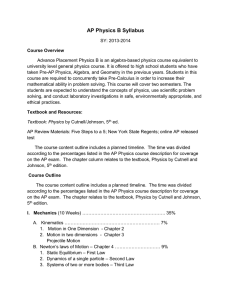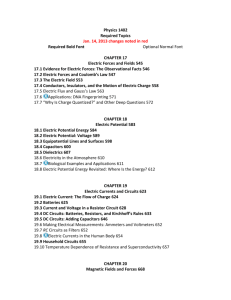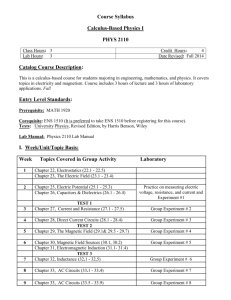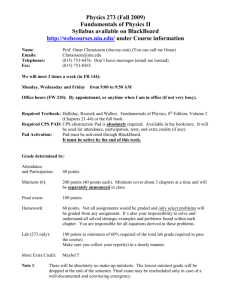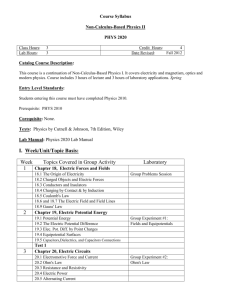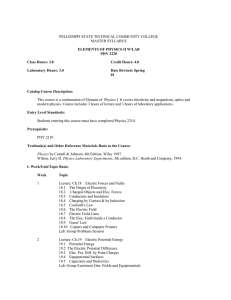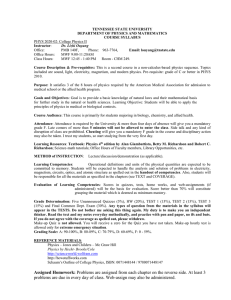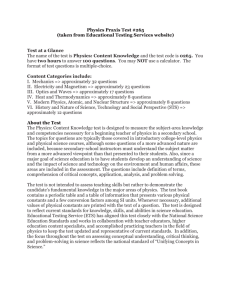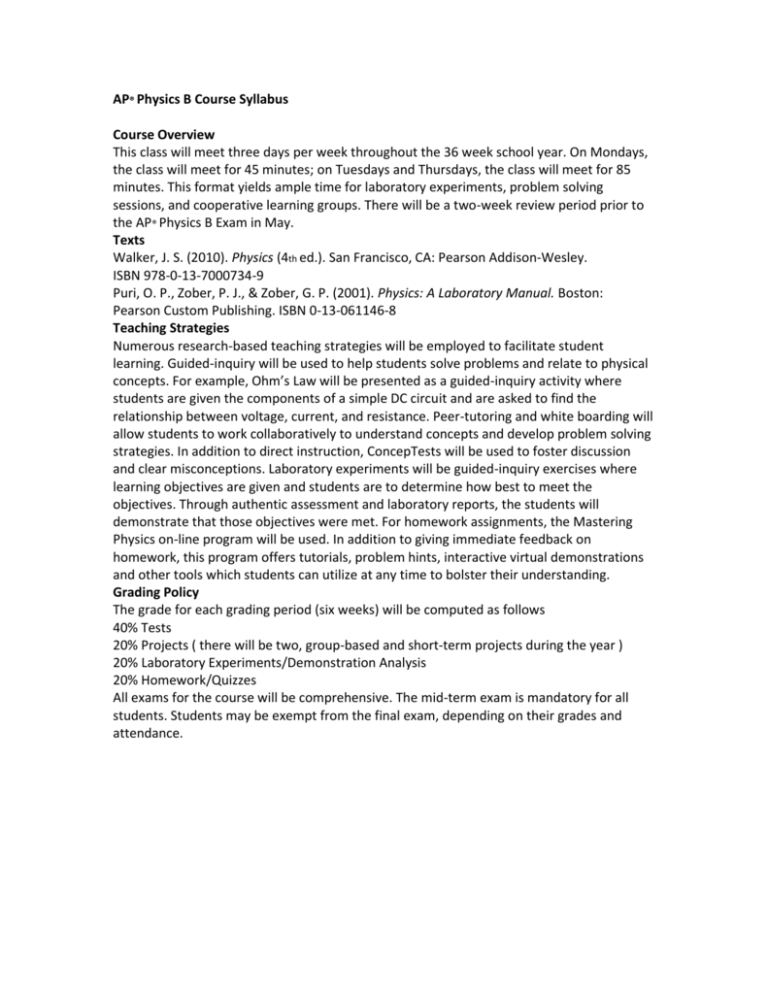
AP® Physics B Course Syllabus
Course Overview
This class will meet three days per week throughout the 36 week school year. On Mondays,
the class will meet for 45 minutes; on Tuesdays and Thursdays, the class will meet for 85
minutes. This format yields ample time for laboratory experiments, problem solving
sessions, and cooperative learning groups. There will be a two-week review period prior to
the AP® Physics B Exam in May.
Texts
Walker, J. S. (2010). Physics (4th ed.). San Francisco, CA: Pearson Addison-Wesley.
ISBN 978-0-13-7000734-9
Puri, O. P., Zober, P. J., & Zober, G. P. (2001). Physics: A Laboratory Manual. Boston:
Pearson Custom Publishing. ISBN 0-13-061146-8
Teaching Strategies
Numerous research-based teaching strategies will be employed to facilitate student
learning. Guided-inquiry will be used to help students solve problems and relate to physical
concepts. For example, Ohm’s Law will be presented as a guided-inquiry activity where
students are given the components of a simple DC circuit and are asked to find the
relationship between voltage, current, and resistance. Peer-tutoring and white boarding will
allow students to work collaboratively to understand concepts and develop problem solving
strategies. In addition to direct instruction, ConcepTests will be used to foster discussion
and clear misconceptions. Laboratory experiments will be guided-inquiry exercises where
learning objectives are given and students are to determine how best to meet the
objectives. Through authentic assessment and laboratory reports, the students will
demonstrate that those objectives were met. For homework assignments, the Mastering
Physics on-line program will be used. In addition to giving immediate feedback on
homework, this program offers tutorials, problem hints, interactive virtual demonstrations
and other tools which students can utilize at any time to bolster their understanding.
Grading Policy
The grade for each grading period (six weeks) will be computed as follows
40% Tests
20% Projects ( there will be two, group-based and short-term projects during the year )
20% Laboratory Experiments/Demonstration Analysis
20% Homework/Quizzes
All exams for the course will be comprehensive. The mid-term exam is mandatory for all
students. Students may be exempt from the final exam, depending on their grades and
attendance.
Course Outline
I. NEWTONIAN MECHANICS
A. Kinematics
1. One-dimensional
2. Two-dimensional (including projectile motion)
B. Newton’s Laws of Motion
1. Static equilibrium (1st law)
2. Dynamics of a single particle (2nd law)
3. Systems of objects (3rd law)
C. Work, Energy, and Power
1. Work and work-energy theorem
2. Forces and potential energy
3. Conservation of energy
4. Power
D. Linear Momentum
1. Impulse and momentum
2. Conservation of linear momentum, collisions
E. Circular Motion and Rotation
1. Uniform circular motion
2. Torque and rotational statics
F. Oscillations and Gravitation
1. Simple harmonic motion
2. Mass on a spring
3. Pendulum and other oscillations 3
4. Newton’s law of gravity
5. Orbits of planets and satellites
II. FLUID MECHANICS AND THERMAL PHYSICS
A. Fluid Mechanics
1. Hydrostatic pressure
2. Buoyancy
3. Fluid flow continuity
4. Bernoulli’s equation
B. Temperature and Heat
1. Mechanical equivalent of heat
2. Heat transfer and thermal expansion
C. Kinetic Theory and Thermodynamics
1. Ideal gases
a) kinetic model
b) ideal gas law
2. Laws of thermodynamics
a) first law (including pV diagrams)
b) second law (including heat engines)
III. ELECTRICITY AND MAGNETISM
A. Electrostatics
1. Charge and Coulomb’s law
2. Electric field and electric potential (including point charges)
B. Conductors, Capacitors, Dielectrics
1. Electrostatics with conductors 4
2. Capacitors
a) capacitance
b) parallel plate
C. Electric Circuits
1. Current, resistance, power
2. Steady-state direct current circuits with batteries and resistors
3. Capacitors in steady state circuits
D. Magnetic Fields
1. Forces on moving charges in magnetic fields
2. Forces on current-carrying wires in magnetic fields
3. Fields of long current-carrying wires
E. Electromagnetism
1. Faraday’s law
2. Lenz’s law
IV. WAVES AND OPTICS
A. Wave Motion (including sound)
1. Traveling waves
2. Wave propagation
3. Standing waves
4. Superposition
B. Physical Optics
1. Interference and diffraction
2. Dispersion of light and the electromagnetic spectrum
C. Geometric Optics 5
1. Reflection and refraction
2. Mirrors
3. Lenses
V. ATOMIC AND NUCLEAR PHYSICS
A. Atomic Physics and Quantum Effects
1. Photons, photoelectric effect, Compton scattering, x-rays
2. Atomic energy levels
3. Wave-particle duality
B. Nuclear Physics
1. Nuclear reactions
2. Mass-energy equivalence
Laboratory Experience
Laboratory experiments are an integral part of the course and will be conducted as guided
inquiry exercises. Students will work in groups to conduct experiments but each student will
be expected to write a report in his/her lab notebook for each of the experiments. The
format and guidelines for each report will be provided by the instructor, but students will
generally be required to organize the experiment, collect data, perform calculations, analyze
data and write conclusions. The final required laboratory experiment will consist of an openended inquiry lab where students determine their own objectives (with instructor approval)
prior to designing and conducting the experiment.
Experiments
1. Graphing
2. Physical Models
3. Uniformly Accelerated Motion on an Inclined Plane
4. Air Resistance
5. Coefficients of Friction
6. Elastic Collisions
7. Turning Point
8. Whirligig
9. Hooke’s Law and Harmonic Motion
10. Ohm’s Law
11. Electrical Power and Batteries 6
12. Magnetic Fields
13. Index of Refraction
14. Diffraction Grating
15. Planck’s Constant
16. The Photoelectric Effect
17. Discovery Lab
Note: Other hands-on activities will be conducted throughout the course to help students
gain a better understanding of physical concepts.
Lab safety will be considered top priority. Students are expected to follow all lab safety
rules, read instructions, and ask questions if unsure how to proceed. Closed toe shoes and
safety glasses will be required for all work in the laboratory.

